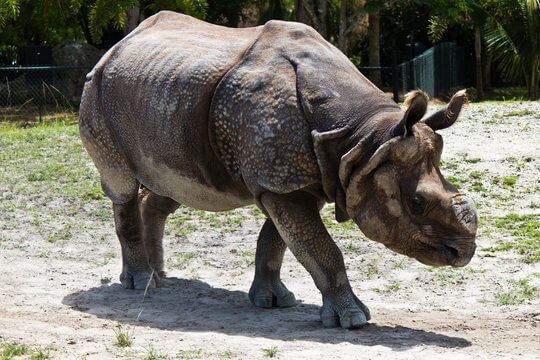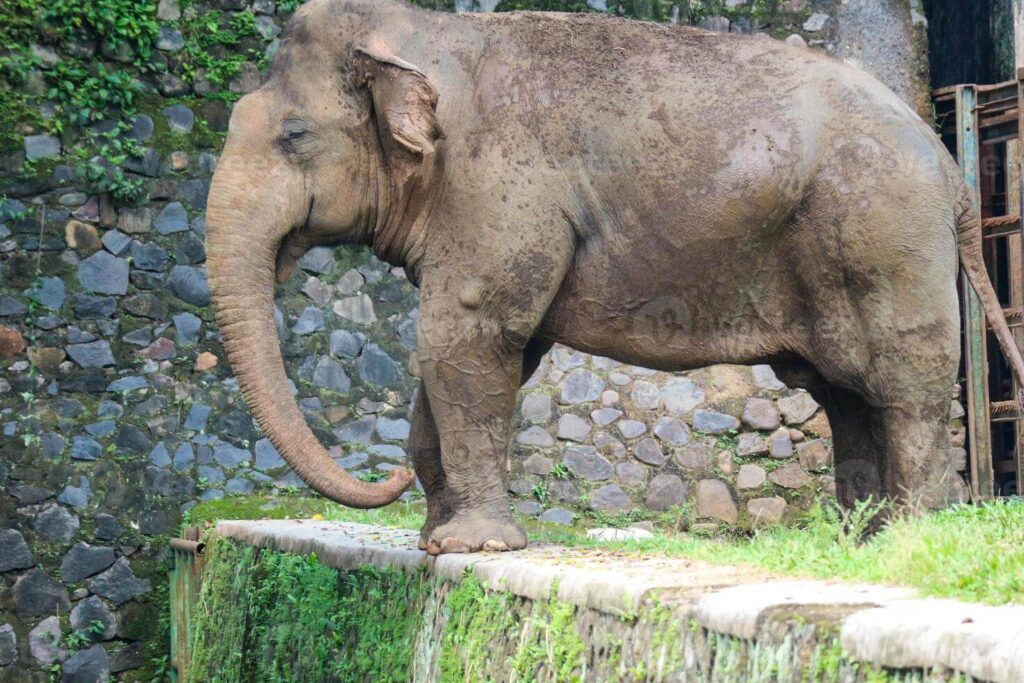In the intricate tapestry of Earth’s biodiversity, certain species emerge as extraordinary rarities, captivating both the imagination and the dedication of conservationists worldwide. As we embark on this journey, we’ll introduce you to the 10 rarest animals in the world, shedding light on their scientific names, their elusive habitats, and the urgent need for their protection.
10 Rarest Animals In The World
1. Javan Rhino (Rhinoceros sondaicus):

- Location: Ujung Kulon National Park, Indonesia
- Status: Critically Endangered
The Javan Rhino, with its solitary horn, stands as one of the rarest large mammals globally. With fewer than 70 individuals left, this critically endangered species fights for survival against habitat loss and poaching. These magnificent creatures once roamed across Southeast Asia but have dwindled to a single population in Indonesia’s Ujung Kulon National Park. Intensive conservation efforts aim to protect their fragile habitat and guard against the ever-present threat of poachers seeking their valuable horns, which are sadly believed to have medicinal properties in some cultures.
These gentle giants play a vital role in their ecosystem by shaping their environment through their feeding habits, yet they remain critically endangered due to their restricted range and the ongoing threats they face. The Javan Rhino reminds us of the importance of preserving Earth’s dwindling biodiversity.
2. Vaquita (Phocoena sinus):

- Location: Gulf of California, Mexico
- Status: Critically Endangered
Inhabiting the Gulf of California, the vaquita is the world’s smallest and rarest porpoise. With less than 10 individuals, their existence hangs by a thread, mainly due to accidental bycatch in gillnets, habitat degradation, and illegal wildlife trade. Despite being the most endangered marine mammal on Earth, the vaquita remains an elusive and enigmatic creature, seldom seen by human eyes.
Conservationists work tirelessly to protect these diminutive porpoises, with efforts focused on enforcing fishing regulations, developing alternative fishing methods, and raising awareness about the vaquita’s critical plight. Their struggle for survival represents a broader challenge facing marine species in an era of rampant overfishing and habitat destruction.
3. Kakapo (Strigops habroptilus):

- Location: New Zealand
- Status: Critically Endangered
The Kakapo, a nocturnal parrot, is the world’s rarest parrot species, with just over 200 individuals. Conservationists’ tireless efforts aim to safeguard this unique ground-dwelling bird from predators and habitat loss. Once widespread in New Zealand, the Kakapo faced severe population declines due to predation by introduced species like rats and cats, as well as habitat degradation.
Kakapos are known for their endearing personalities, with each bird having its unique name and distinct behaviors. Conservationists have implemented intensive management, including supplementary feeding and the transfer of chicks to predator-free islands, to help rebuild their population. The Kakapo’s story serves as a beacon of hope for the conservation of other endangered species and the power of dedicated human intervention.
4. Sumatran Elephant (Elephas maximus sumatranus):

- Location: Sumatra, Indonesia
- Status: Critically Endangered
The Sumatran Elephant, a subspecies of the Asian elephant, grapples with habitat fragmentation and human-wildlife conflicts. Less than 2,800 individuals remain in fragmented forests. These magnificent creatures play an essential role in maintaining the health of their ecosystems by dispersing seeds and creating pathways through dense vegetation.
The Sumatran Elephant’s survival depends on preserving their remaining habitat and finding ways to mitigate human-elephant conflicts, which often result from habitat encroachment. Conservation organizations collaborate with local communities to develop solutions that protect both the elephants and the livelihoods of those who share their habitat. The Sumatran Elephant’s future hangs in the balance, reflecting the broader conservation challenges faced by large mammals across the globe.
This revised article provides a more comprehensive explanation of the first four rare animals, including their current status, habitats, and conservation efforts. If you’d like to continue with the explanations for the remaining six rare animals, please let me know.
5. Pinta Island Tortoise (Chelonoidis abingdoni):

- Location: Galápagos Islands
- Status: Extinct in the Wild
The Pinta Island Tortoise, scientifically known as Chelonoidis abingdoni, holds a tragic distinction—it’s the first giant tortoise species to be declared extinct in the wild. The last-known individual of this species, famously named Lonesome George, passed away in 2012. The Pinta Island Tortoise once thrived across its native Galápagos Islands but was driven to the brink of extinction by invasive species introduced by humans, habitat changes, and over-exploitation.
Despite the extinction of the Pinta Island Tortoise in the wild, there is still hope for its genetic legacy. Efforts to restore similar tortoise species in the Galápagos are underway, using individuals with Pinta Island Tortoise DNA in their lineage. This serves as a poignant reminder of the critical importance of preserving the unique biodiversity of the Galápagos Islands and protecting the remaining giant tortoise species.
6. Northern Hairy-Nosed Wombat (Lasiorhinus krefftii):

- Location: Queensland, Australia
- Status: Critically Endangered
The Northern Hairy-Nosed Wombat, scientifically known as Lasiorhinus krefftii, stands as one of the world’s rarest marsupials. With fewer than 300 individuals left, their range is confined to a single national park in Queensland, Australia. These endearing, burrowing creatures face dire threats, primarily stemming from habitat degradation due to invasive plant species and overgrazing by livestock.
Conservation efforts are focused on preserving their habitat and creating a safe haven for these wombats. Scientists, conservationists, and local communities collaborate to combat invasive species and raise awareness about the importance of these unique marsupials in their ecosystem. The Northern Hairy-Nosed Wombat’s survival is emblematic of the broader challenges facing Australia’s unique wildlife in the face of habitat alteration and introduced species.
These comprehensive explanations provide a deeper understanding of the next two rare animals on the list. If you’d like to continue with explanations for the remaining four rare animals, please let me know.
7. Spix’s Macaw (Cyanopsitta spixii):

- Location: Brazil
- Status: Critically Endangered
The Spix’s Macaw, also known as the Little Blue Macaw, is a bird of unparalleled beauty and rarity. It’s a striking symbol of the Amazon rainforest and the vibrant biodiversity that once thrived in Brazil. Sporting an exquisite cobalt-blue plumage and long, elegant tail feathers, this parrot species captivates all who have the privilege of witnessing it. However, the Spix’s Macaw teeters on the brink of extinction, with only a handful of individuals remaining in the wild.
The main culprit behind its critically endangered status is habitat destruction, primarily through deforestation. As the Amazon rainforest continues to shrink due to logging, agriculture, and urban expansion, the Spix’s Macaw loses its natural home and food sources. Additionally, illegal trapping for the pet trade has taken a devastating toll on their population. The Spix’s Macaw serves as a poignant reminder of the urgent need for habitat preservation and wildlife protection in the face of relentless human activities.
Conservationists and governments have launched intensive efforts to save this majestic bird from vanishing forever. Captive breeding programs aim to bolster its numbers, and habitat restoration projects offer hope for its eventual return to the wild. Yet, the road to recovery is fraught with challenges, and the future of the Spix’s Macaw remains uncertain. Its plight is a microcosm of the broader conservation struggle to protect parrot species worldwide, which face similar threats of habitat loss and poaching.
8. Angel Shark (Squatina squatina):

- Location: Northeast Atlantic and Mediterranean
- Status: Critically Endangered
The angel shark, a true marvel of the deep, is a creature that once cruised the seafloors of the northeast Atlantic and Mediterranean in abundance. With its flat, ray-like body and a set of wing-like pectoral fins, it earned its name from its ethereal, otherworldly appearance. However, this enigmatic predator now faces a dire fate, pushed to the brink of extinction.
One of the primary threats to the angel shark is overfishing. Historically, these sharks were unintentionally captured as bycatch in fishing nets and lines, but their numbers have dwindled to dangerously low levels. Additionally, habitat degradation in the form of trawling and pollution has further compromised their populations. As apex predators, angel sharks play a crucial role in maintaining the health of marine ecosystems by controlling the populations of their prey species.
Conservationists are working diligently to protect this ancient species. Initiatives include the implementation of fishing regulations that reduce bycatch, the creation of marine protected areas where angel sharks can thrive undisturbed, and educational programs to raise awareness about the critical importance of their preservation. The angel shark’s plight underscores the pressing need to conserve vulnerable marine species and safeguard the oceans they inhabit, reminding us of the interconnectedness of all life on Earth.
9. Hainan Gibbon (Nomascus hainanus):

- Location: Hainan Island, China
- Status: Critically Endangered
The Hainan Gibbon, a critically endangered species, is among the rarest primates on our planet. This small, dark-furred gibbon is native to Hainan Island in China, and its existence is hanging by a thread, with fewer than 30 individuals remaining in the wild. Their critical status is primarily due to deforestation, habitat fragmentation, and hunting.
The Hainan Gibbon’s unique, haunting calls echo through the dense forests of Hainan Island. These calls, which are used for communication and territory marking, are a poignant reminder of the urgent need to protect this extraordinary primate species. Conservation efforts are underway, focusing on habitat preservation, anti-poaching measures, and community engagement to ensure the survival of the Hainan Gibbon. This rare gibbon stands as a testament to the delicate balance between human development and wildlife conservation, highlighting the importance of preserving their fragile habitat.
10. Iberian Lynx (Lynx pardinus):

- Location: Spain and Portugal
- Status: Endangered
The Iberian Lynx, once on the brink of extinction, has seen a glimmer of hope thanks to dedicated conservation efforts. This medium-sized wild cat, native to the Iberian Peninsula in Spain and Portugal, was perilously close to vanishing due to habitat loss and human-wildlife conflicts. However, concerted initiatives have led to a slight recovery in their numbers.
Conservationists have focused on various strategies, including habitat restoration, captive breeding, and reducing human threats, such as accidental trapping and vehicle collisions. The Iberian Lynx’s story serves as a reminder of the resilience of nature when met with determined human intervention. Although they are no longer critically endangered, they remain endangered, highlighting the ongoing challenges faced by predators in a changing world.
The Iberian Lynx’s survival journey reminds us of the power of conservation and collective action in preserving our planet’s most magnificent and endangered species.
Also Read:-
- The Biggest Eagles in the World!
- Types of dragons
- Snakes in Kentucky
- 30 Types of Wild Dogs with Species & Images
- Are Wolves the Ultimate Meat Lovers? Find Out!
Conclusion
In conclusion, the world’s rarest animals stand as both a testament to nature’s incredible diversity and a stark reminder of the urgent need for conservation. Each of these remarkable creatures, from the elusive Javan Rhino to the resurgent Iberian Lynx, embodies the fragile balance of life on our planet. Their stories reveal the profound impact of human activities on the natural world, underscoring the responsibility we bear in safeguarding their habitats and futures.
As we gaze upon the rarest animals, we’re reminded that their preservation isn’t just a matter of scientific interest; it’s a moral imperative. Their survival hinges on collaborative efforts, from habitat restoration to stringent protection measures. Together, we must strive to ensure these living treasures continue to grace our planet, inspiring wonder and serving as ambassadors for the importance of biodiversity conservation. With dedication, awareness, and collective action, we can secure a brighter future for both these extraordinary creatures and the delicate ecosystems they call home.

